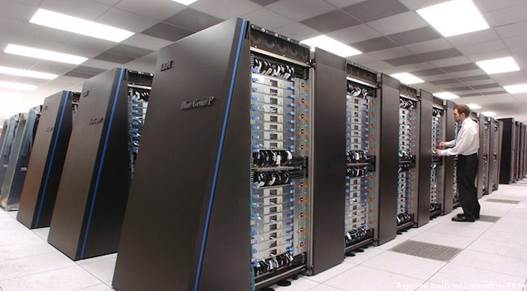The impact rapidly increasing data
growth has on data centers
Arguably, there's never been a better time
for businesses to be excited about the data their employees and business units
are generating. Software such as analytics and business intelligence are
enabling organizations to harness big data to gain greater insight into their
customers and business processes, resulting in new avenues of revenue and
profitability, improved customer communication and retention, reduced IT
costs, and other benefits.
On the other hand, data is being generated
perpetually and at unprecedented levels due in large part to the massive
numbers of mobile and Internet connected devices now in use. Further,
effectively processing and analyzing the huge amount of structured and unstructured
data these devices generate in the form of Geolocation, audio, video, and photo
files; tweets; Web posts; and other unconventional data files is difficult via
traditional databases and software.
Thus, although businesses are justifiably
interested in adopting big data initiatives, there's the pertinent question of
how adopting and preparing for a big data initiative will impact the data
center in terms of storage.

Enterprise
Big Data demands a lot of infrastructure.
State of storage
Undeniably, data is growing at staggering
levels globally. IDC Research (www.idc.com) reported that in 2000, all new data
created globally totaled about 2 million terabytes. Currently, double this
amount is generated daily. Last year, IDC reported that 1.8 zettabytes (1.8
trillion gigabytes) was generated worldwide, and by 2015 roughly 8,000
Exabytes will be generated and stored globally.
Helping produce this data are smartphones,
tablets, digital cameras, mobile sensors, smart meters, and other always connected
devices, in addition to offline and mobile data that makes its way onto company
networks. Although individuals generate 75% of data in the digital universe,
IDC states, enterprises have some liability for 80% of it during the data's
digital lifespan. In coming years, this situation will continue, though IT
staff pools tasked with managing data are predicted to grow only slightly.
Moreover, IDC states that digital growth is outpacing storage capacity growth.
Elsewhere, in a recent survey of 30
enterprises, Aberdeen Group (www.aberdeen.com) found 58% of respondents listed
the growing demand for storage capacity as one of their three top IT job pressures,
"making it by far the most widely felt concern among professionals from
companies of all sizes." Aberdeen's research also revealed that storage
capacity in enterprises grew 35% from 2010 to 2011, although 8% of those
surveyed indicated data grew between 90% and 140%, while another 6% said it increased
more than 150% per year. The average growth for large enterprises was 44%, a
rate Aberdeen states would require data capacity to double every 1.5 years.
"Unless organizations get smarter and more efficient, they will almost
annually need twice the number of storage devices, twice the space in the data
center, and twice the personnel time and effort to manage their business
data," Aberdeen states.
A recent CompTIA survey of 500 U.S.
businesses found that many respondents must address basic data needs and
technology infrastructure before launching big data initiatives.
"Substantial" obstacles indicated as existing related to high or
moderate degrees of data silos within organizations, many organizations
lacking a complete or accurate understanding of their data profiles, and few
companies having comprehensive business continuity and disaster recovery
plans in place.

A
recent CompTIA survey of 500 U.S. businesses found that many respondents must
address basic data needs and technology infrastructure before launching big data
initiatives.
Big data’s storage impact
In terms of storage and other data center
infrastructure components, tackling a big data initiative can prove a major
challenge for any business no matter its size. SMEs (small and medium-sized
enterprises) specifically, says Dick Csaplar, Aberdeen Group senior research
analyst, storage and virtualization, "will need to have capabilities built
into their storage devices, as they have few, if any, trained IT resources to
manage the process."
John Robosson, Navint (www.navint.com)
partner, says big data comprises a "vast array of heterogeneous data
sources that requires careful analysis to determine an overall big data
strategy." The notion that an average SME can "capture, store, and
analyze all data to produce meaningful business intelligence isn't often
achievable," he says, which is why it's imperative to develop a big data
roadmap first. Big data's biggest impact on data center infrastructure, he
says, will involve non-relational and unstructured data that a company
determines has business intelligence value. "Capturing, indexing, storing,
and retrieving new data types will present significant challenges to most SME
data centers," he says.

In
terms of storage and other data center infrastructure components, tackling a
big data initiative can prove a major challenge for any business no matter its
size
Ben Woo, Neuralytix (www.neuralytix.com)
managing director, doubts SMEs will introduce in house big data activities in
the near future but does foresee a surge of big data-as-a-service offerings
popping up. Here, he says, SMEs can leverage cloud storage and existing
storage. Initially, big data likely won't have a major impact on an SME's data
center infrastructure storage-wise, Woo says, as most data is already in
existing systems or sourced from a third party. There will be incremental
storage necessary to support a big data analytics framework, he says, and as
enterprises retain more data for analytical purposes, storage is then
"likely to increase quite dramatically," with 100% increases in
capacity demands not being unusual.
Evan Quinn, ESG (Enterprise Strategy
Group; www.esg-global.com) senior principal analyst, says companies should
expect big data storage requirements similar to existing data warehousing,
data mart, and business intelligence solutions. As a result of a flood of
third-party data into big data analytics, new data sources (such as social
networks), and an increased rate of real-time and near real-time data, most
organizations must be "on their toes in terms of information management
practices and related storage infrastructure," in order to create an
ongoing, fully functional big data solution.
To eliminate guesswork from the big data
equation, Quinn says, many big data vendors are wrapping infrastructure and
software into an appliance, because big data requires balancing CPU, memory,
compression, cache, storage, and network bandwidth to work right. Rather than
storage, he says, availability is the biggest hurdle most companies face with
big data. "And that implies the entire infrastructure," Quinn says.